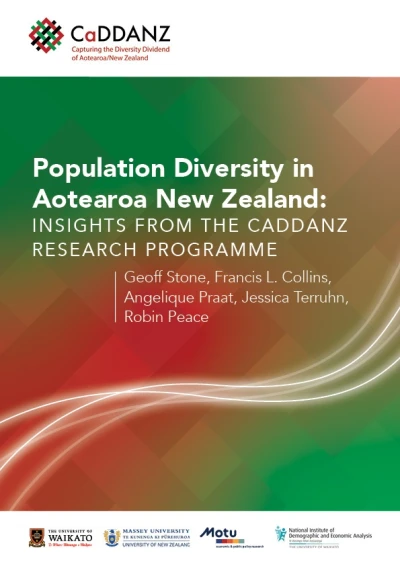
Capturing the Diversity Dividend of Aotearoa/New Zealand (CaDDANZ, pronounced 'cadence') was a research programme led by teams from the University of Waikato and Massey University. The team also included staff from Motu Economic and Public Policy Research in Wellington. It was funded by the Ministry of Business, Innovation and Employment from October 2014 - March 2021 (an extension of six months from the initial end date of October 2020 following Covid-19 interruptions.
We investigated the changing 'face' of New Zealand and how rapidly this was occuring as a consequence of the settlement of migrants from throughout the world, temporary and circular international migration, growing ethnic diversity, population ageing, changing fertility patterns and urban growth.
We set out to identify how New Zealand can better prepare for, and respond to, these demographic changes in order for the country to maximise the benefits associated with an increasingly diverse population.
The research measured, mapped and analysed the complex societal impacts of diversity and the implications for businesses, households and communities of mobility, migration indigeneity, ethnic identity, demographic change (including structural ageing and fertility) and urban/regional disparities. A significant component of the research is concerned with the implications of diversity for Maori and with how Maori engage with diversity.
Our internationally recognised, interdisciplinary research team worked across three major research themes.
- Ethno-demographic diversity
- Societal impacts and opportunities
- Institutional implications and responses.
Population Diversity in Aotearoa New Zealand: Insights from the CaDDANZ research programme
 The report introduces CaDDANZ and its key findings, before discussing insights in relation to population trends in Aotearoa, reconceptualising ethno-demographic diversity from Māori perspectives, diversity in context and lastly providing a series of conclusions and recommendations. Each of the sections and subsections make reference to reports and other publications that can be accessed to gain more detailed insight into particular issues, as well as identifying key CaDDANZ researchers who have led particular studies within the programme.
The report introduces CaDDANZ and its key findings, before discussing insights in relation to population trends in Aotearoa, reconceptualising ethno-demographic diversity from Māori perspectives, diversity in context and lastly providing a series of conclusions and recommendations. Each of the sections and subsections make reference to reports and other publications that can be accessed to gain more detailed insight into particular issues, as well as identifying key CaDDANZ researchers who have led particular studies within the programme.
Contact us
Should you have any queries about the CaDDANZ research project please email: nidea@waikato.ac.nz or phone: +64 7 838 4040